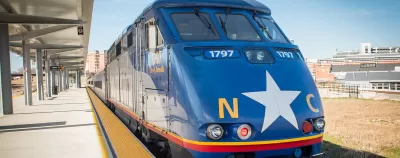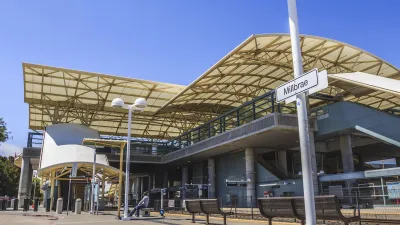The passenger rail line will connect Raleigh and Richmond as part of the growing Southeast Corridor.

Federal and state officials celebrated the groundbreaking of a new high-speed rail line that will connect Raleigh, North Carolina and Richmond, Virginia, according to an article by Flynn Nicholls in Newsweek.
“Currently, the passenger rail route from Richmond to Raleigh is 190 miles and takes 3 hours and 45 minutes. The project aims to refurbish and extend an existing freight-only line between the two cities to create a more direct route, with the eventual intention of running a 110-mile-per-hour passenger service.”
As Nicholls explains, “The Raleigh to Wake Forest section received $1.1 billion of federal funding in December 2023. The project includes new and upgraded tracks for the 18-mile section, 11 grade separations, and the closure of multiple at-grade crossings.”
The project is part of the federally designated Southeast Corridor, which serves Florida, Georgia, North Carolina, South Carolina, Tennessee, Virginia, and Washington, D.C.
FULL STORY: Construction Begins on New High-Speed Rail Line

Trump Administration Could Effectively End Housing Voucher Program
Federal officials are eyeing major cuts to the Section 8 program that helps millions of low-income households pay rent.

Planetizen Federal Action Tracker
A weekly monitor of how Trump’s orders and actions are impacting planners and planning in America.

The 120 Year Old Tiny Home Villages That Sheltered San Francisco’s Earthquake Refugees
More than a century ago, San Francisco mobilized to house thousands of residents displaced by the 1906 earthquake. Could their strategy offer a model for the present?

HSR Reaches Key Settlement in Northern California City
The state’s high-speed rail authority reached an agreement with Millbrae, a key city on the train’s proposed route to San Francisco.

Washington State Legislature Passes Parking Reform Bill
A bill that would limit parking requirements for new developments is headed to the governor’s desk.

Missouri Law Would Ban Protections for Housing Voucher Users
A state law seeks to overturn source-of-income discrimination bans passed by several Missouri cities.
Urban Design for Planners 1: Software Tools
This six-course series explores essential urban design concepts using open source software and equips planners with the tools they need to participate fully in the urban design process.
Planning for Universal Design
Learn the tools for implementing Universal Design in planning regulations.
Ada County Highway District
Clanton & Associates, Inc.
Jessamine County Fiscal Court
Institute for Housing and Urban Development Studies (IHS)
City of Grandview
Harvard GSD Executive Education
Toledo-Lucas County Plan Commissions
Salt Lake City
NYU Wagner Graduate School of Public Service





























